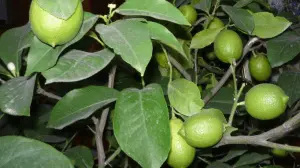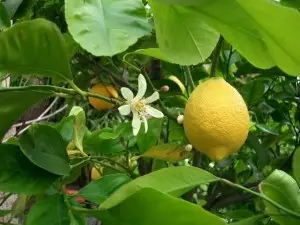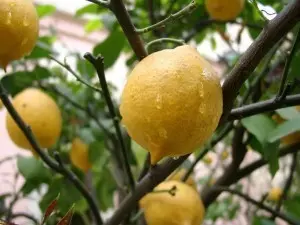Contents
Green throughout the year, Pavlovsky lemon occupies a special place among house plants. It is not particularly whimsical in care, has a decorative appearance and always green foliage, and its fruits are in no way inferior to imported ones in taste.
Variety description
Back in the eighteenth century, one of the wealthy merchants of curtains in the city of Pavlov had several seedlings of an outlandish plant from Turkey at that time. Over time, the overseas exotic tree won the hearts of the townspeople, and its cuttings began to be propagated throughout Pavlovo. That’s how Pavlovsk lemons appeared. In a short time, this plant has gained wide popularity in Moscow. You can get acquainted with the appearance of the bush, its fruits in the next photo.

Appearance
Lemon Pavlovsky variety of bushy. An adult plant reaches 0,8-1,4 m in height. It has a rounded crown 0,6-1,2 m in diameter with 2-4 skeletal branches. On young shoots the bark is dark green, mature branches have olive-gray bark with longitudinal cracks. Almost all Pavlovian lemons have sharp spines on branches 1-1,5 cm long.
The leaves are large, 12-14 cm long, with a wedge-shaped base and a long pointed apex. The shape is different, depending on the species, it can be broadly oval, oblong, oval, broadly lanceolate or obovate. The leaves are bright, shiny green or dark green. The petiole is short, with a small groove. You should know that Pavlovian lemons periodically shed old foliage. However, experts have found that in the crown of a healthy tree, each fruit should have at least 8-12 physiologically active leaves.
Flowering and fruits
The flowers are large, bisexual, 2,5-3,5 cm in diameter, located singly in the axils of the leaf or in inflorescences of 2-3 pieces. Pavlova’s lemon is a self-pollinating variety. The flowering period is in early spring or autumn, however, this species can bloom all year round, with proper care, so it is not uncommon for one bush to have almost ripe fruits and very green ovaries.
Fruiting begins from 3-4 years after rooting. Lemon may bloom earlier, but in this case, flowers should be removed, giving the plant the opportunity to take root and grow stronger. The yield is average, about 6-8 lemons annually. Fruit quality is high. The aging time, depending on the lighting, ranges from 35-40 days to 2,5-3 months.

Growing conditions
At the moment, Pavlovian lemons are actively bred in nurseries in Moscow and other cities throughout Our Country. They propagate by semi-lignified cuttings, air layering or seeds. Since this is a southern subtropical plant, it is extremely demanding on heat, light, moisture and nutrition.
Lemon does not tolerate direct sunlight, so keep them on the south window, shading it in the summer. In winter, it is necessary to provide the plant with additional illumination for the speedy ripening of fruits and active growth, using only fluorescent lamps.
The temperature in the room should not be lower than 19-23C, since lemon is a heat-loving plant. Drafts should be avoided. In winter, the plant is watered with slightly heated water, up to 30C, since the hypothermia of the earthy coma reduces the activity of the root system, as a result of which the supply of water and nutrients to the leaves is delayed.
Humidity in the room must be maintained at 65-73%. Regular spraying of the deciduous part of the plant avoids the evaporation of excess moisture from the leaves and saves them from premature fall. Under the crown, next to the pot, in winter, you should put a container of water and ventilate the room. To ripen large and tasty lemons, you need to regularly moisten the stalk with warm water.

Features of care
Indoor lemon reacts strongly to the humidity of an earthy coma, lack of nutrition and ambient temperature. With excessively dry soil and low air humidity, Pavlovsk lemons actively shed their leaves, cease to bear fruit, and slow down their growth and development. It is necessary to water the plant regularly, but not more than twice a week, checking the moisture content of the earthy coma to the touch. In addition, it is imperative to apply various complex fertilizers and minerals, especially during the growing season.
In order not to weaken the young tree and accelerate further development, it is necessary to remove the flowers for the first 2-3 years after planting, preventing the fruit from setting. Then you can leave 3-4 flowers, and in the future only thin out the closely located flowers and remove the underdeveloped ones. A small amount of fruit should be left, preferably on short branches closer to the base.
Video “Lemon Pavlovsky – growing at home”
How to avoid common care mistakes, create conditions for stable fruiting, provide the plant with the necessary minerals and protect it from diseases and pests, this video tells in detail.









